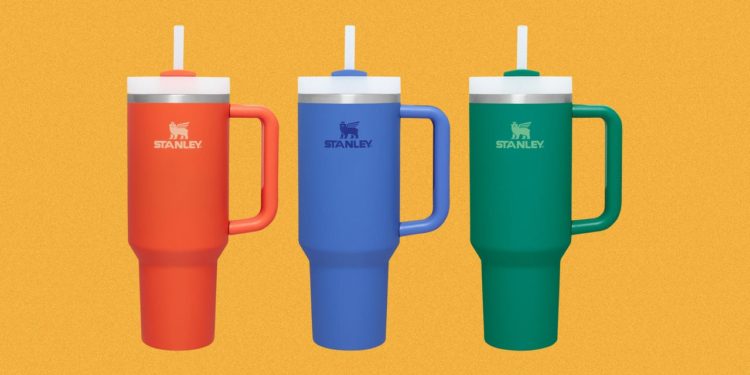By WIRED
You can see the pellet that Stanley refers to at the bottom of your drink container. It seals those layers together where they all meet at the bottom of the bottle, in a process called lead soldering. Technically, the vessel does contain lead, but it’s enclosed with stainless steel and should never come in contact with your drink or skin. However, should you drop the water bottle or if it otherwise gets damaged and this piece of steel comes loose, there’s a chance the lead can be exposed to your skin.
Lead is a naturally occurring toxic metal. The World Health Organization (WHO) cites that there is no safe level of lead exposure. “Once lead enters the body, it is distributed to organs such as the brain, kidneys, liver, and bones.” High levels of lead exposure can be fatal. With lower levels of exposure—which can happen with a microscopic amount—lead poisoning in adults can cause nerve disorders, decreased kidney function, and fertility issues. In children, it can cause developmental delays and seizures. The WHO says children are “particularly vulnerable to lead poisoning because they absorb four to five times as much ingested lead as adults.”
“Lead is ubiquitous in the environment, so low levels of daily exposure are a fact of life,” says Jane Houlihan, national director of science and health at Healthy Babies Bright Futures. “Exposures and risks add up day to day from lead in food, water, house dust, and soil. This makes it all the more important for companies to keep lead out of consumer products. Children don’t need another potential source of lead in their lives.”
What Do Other Brands Use?
Lead soldering is low-cost and easy to use and is a common practice from a variety of manufacturers. However, alternative methods are available. Several of the reusable water bottle companies we reached out to do not use lead in their manufacturing process. Here’s the list:
- Owala (no lead), which makes popular bottles like the FreeSip and a Stanley-dupe tumbler, says it has never used lead in its manufacturing process. “The production of vacuum-sealed containers using lead-free solder is more costly and complicated. However, we made a commitment from day one with Owala to use lead-free solder on our bottles,” an Owala spokesperson says.
- Hydro Flask (no lead since 2013), another internet-famous water bottle company, stopped using lead solder more than 10 years ago. “By mid-2013, the lead was out of the Hydro Flask production process because the brand designed a proprietary sealant, TempShield,” a Hydro Flask spokesperson says.
- Klean Kanteen (no lead) also forgoes lead, instead using a noncrystalline silica bead to create its vacuum-insulated bottles. “The process, using silica instead of lead, is the same except higher heat is required to melt the silica,” says Rich Haver, the company’s director of global operations. While some forms of silica can be dangerous if very fine particles are inhaled—sand is made from crystalline silica, so even finer than that—this doesn’t apply to noncrystalline silica glass. “Silica in its noncrystalline form does not have the same respiratory health properties as crystalline silica,” says Marty Cohen, a teaching professor in the Department of Environmental and Occupational Health Sciences at the University of Washington.
- MiiR (lead used) confirmed its use of lead in its manufacturing process with some of its products. According to its website, “This pellet does contain lead for manufacturing efficiency, waste reduction, and to ensure a complete seal. For these reasons and because there is zero lead exposure, MiiR utilizes this process with confidence.”
- LifeStraw (lead used) makes straws and filtered bottles that remove bacteria, microplastics, and parasites from water. We really liked the Go Series Filtered Water Bottle for this reason. That makes it the most surprising company to confirm it uses “a lead soldering dot as part of the manufacturing sealing process.”
- Other brands (unknown): The following companies have not responded to our requests for comment: Yeti, S’well, HydroJug, and Greens Steel. (Sigg responded but has not given us an answer yet. We will update this story when they do.)
The Problem With Lead in Manufacturing
Even if the cup or bottle is never damaged and you’re never exposed to lead, if it’s used in the manufacturing process, workers are still around the material in some way. The solder training institute EPTAC says on its website that the amount of lead on solders is likely not going to cause severe health problems, but there’s still a risk for workers exposed to lead during the process.
“When lead is used in manufacturing, there is a risk of lead exposure for consumers of those products, especially for products intended for use in food consumption, like drinkware,” says a representative for the Centers for Disease Control and Prevention. “There is also a potential occupational safety risk for workers and, without proper safeguards, could be a risk for workers’ families through take-home lead exposures.”
If your Stanley bottle or cup gets damaged, you can ask for a replacement under Stanley’s lifetime warranty. We asked Stanley if customers could return undamaged cups, or if the company plans to change its manufacturing process, but it only pointed us to the same information page about its use of lead.
If you buy something using links in our stories, we may earn a commission. This helps support our journalism. Learn more.






Discussion about this post